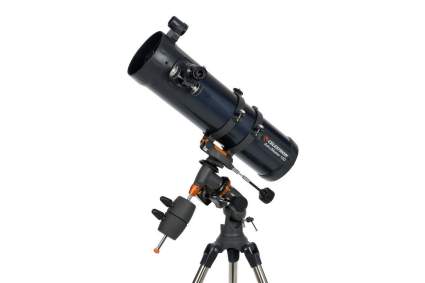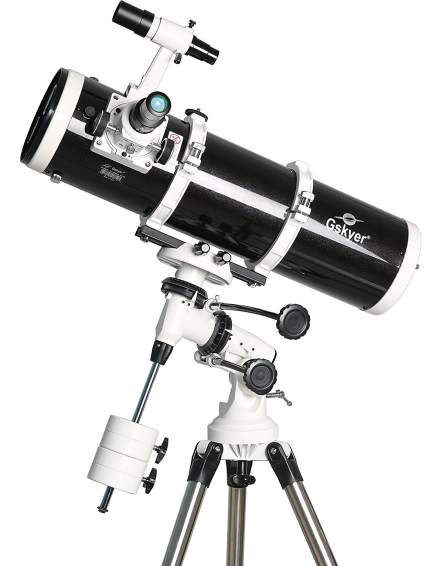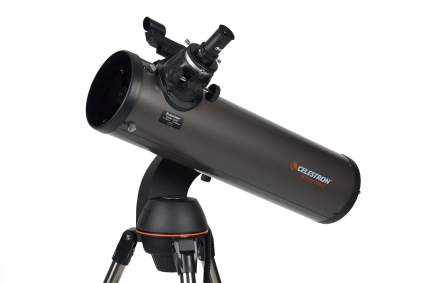
Looking up to the stars is a pastime as ancient as humanity itself. To point a telescope at a celestial object and be able to view it with magnified clarity is something that has only recently become a possibility on the human timeline.
Whether you’re an experienced stargazer whose passion is viewing the heavens, or an amateur astronomer who wants to begin to learn and see some neat celestial objects, we’ve put together an awesome list of some seriously cool telescopes to point toward the stars.

|
Amazon Customer Reviews
|
Price: $219.95 Shop at Amazon | Shop now Read our review |

|
Amazon Customer Reviews
|
Price: $180.88 Shop at Amazon | Shop now Read our review |

|
Amazon Customer Reviews
|
Price: $304.06 Shop at Amazon | Shop now Read our review |

|
Amazon Customer Reviews
|
Price: $330.77 Shop at Amazon | Shop now Read our review |

|
Amazon Customer Reviews
|
Price: $549.99 Shop at Amazon | Shop now Read our review |
-
1. Best General Purpose Low Cost Telescope: Celestron 127EQ PowerSeeker Telescope
Pros:- Very affordable, great value telescope
- Simple to assemble and to operate, great for learning how to use a telescope
- Two year warranty
Cons:- Complaints about the quality of the tripod
- The included eyepieces are somewhat limiting, you’ll likely want to purchase the accessory kit and some other eyepieces with this one
- Fairly heavy unit
Here’s a great telescope for the amateur or aspiring astronomer. The PowerSeeker 127EQ Telescope by Celestron features a 127mm aperture and 1000mm focal length perfect for someone who wants an affordable and easy to use, first telescope.
There are no tools required for assembly with this one, so putting it together out of the box is a breeze.
It’s essentially as simple as connecting the tripod to the telescope, and then attaching the desired eyepiece – piece of cake. The PowerSeeker 127EQ includes a 3x Barlow lens which triples the magnifying power of each lens. There are two eyepieces included, their focal lengths are 4mm and 20mm.
Celestron even includes some free software with this telescope that you can use to learn and locate thousands of celestial objects. It’s 17 pounds, so this telescope is pretty easy to travel with. There’s a two-year limited warranty included on this unit so you can buy in confidence.
Celestron offers an accessory kit for their PowerSeeker line if you want to expand this telescope’s abilities a bit. For the beginner astronomer, the idea behind this unit is to not waste any time learning to view the night sky in detail.
Find more Celestron 127EQ PowerSeeker Telescope information and reviews here.
-
2. Best Lightweight Portable Telescope: Gskyer Infinity 60mm AZ Refractor Telescope – Travel Scope
Pros:- Awesome portability, truly a scope you can take places
- Very easy to assemble and operate
- Also a solid scope for viewing wildlife and nature
- Quite affordable considering the versatility of this telescope
Cons:- Not a super high powered telescope - if you want to view REALLY distant celestial objects than look elsewhere
- Complaints that the user manual is not great, so you may need to find information online if you’re a less experienced telescope user
- Plastic used for telescope body is not high quality
Here’s an excellent telescope for traveling. This unit by Gskyer is a very lightweight (six pounds) and easy to assemble telescope. Customer reviews rave about this units ability to break down and be set back up with ease.
This 60mm aperture model comes with both low (25mm) and medium (10mm) magnification eyepieces and a 3x Barlow lens. The unit is equipped with a Altazimuth mount with slow motion control. This isn’t a particularly high powered telescope, but for the purposes of viewing the moon and planets, this is a solid choice.
A lot of users of this telescope enjoy viewing wildlife and nature with it as well because of its awesome portability, so don’t forget to consider what else you could do with it. The optics on this unit are made with coated antireflection blue film components, generating a really crisp picture for whatever you want to view.
Because of this telescope’s simplicity, it could be a great introduction to astronomy for kids or adults. This is a great unit to take out with a star chart or a book like John A Read’s “50 Things To See With A Small Telescope”. Gyskyer also includes a one-year limited lifetime warranty on this model.
Find more Gskyer Infinity 60mm AZ Refractor Telescope — Travel Scope information and reviews here.
-
3. Best Affordable Telescope for Viewing Deep Space Objects: Celestron 31045 AstroMaster 130 EQ Newtonian Reflector Telescope
Pros:- Large aperture is good for viewing bright, deep space objects
- Lots of components included that make this telescope very easy to assemble and use once you’ve gained some familiarity with it
- A fine choice for viewing terrestrial objects as well
- Equatorial mount when used properly is praised by customers
Cons:- A lot of experienced astronomers recommend upgrading the lenses that come with this unit to maximize this telescopes capabilities
- On the more expensive end of beginner home telescopes
- Complaints about the stability of the tripod
Here’s a higher quality telescope by Celestron. This unit is very capable, yet Celestron was able to keep its no-tool assembly and operation simple and easy. The Astromaster series is a top reviewed and reasonably affordable line, this telescope being one of the nest value units in the series.
The aperture of this telescope is 130mm and the focal length is 650mm. The highest magnification is 307x. It’s a 28-pound telescope, so it’s a bit on the heavier side but still totally portable. The German equatorial mount with setting circles makes it easy to track celestial objects with this unit.
The quick release dovetail attachment for the tube makes the setup and break down of this telescope quite simple. The permanently mounted star pointer is a very user-friendly way to orient yourself and target objects when getting set up. Furthermore, the erect image optics employed with this unit make this scope great for both terrestrial and astronomical use.
All of the features of this telescope add to its high quality and usability without giving you anything you don’t need. The Newtonian reflector telescopes in the Astromaster series are recommended for viewing brighter deep space objects like galaxies and nebulae, so if that’s what you’re into this is the go-to affordable telescope.
The larger aperture of this scope is what makes it a higher quality unit. Once you become familiar with all the gadgets and components included with this telescope you will no doubt be impressed with the views it generates. This is a good one for beginners and accomplished astronomers alike.
-
4. Best Home Telescope for Attaching a Camera: Gskyer 130EQ Professional Astronomical Reflector Telescope
Pros:- Can receive a SLR camera for taking astronomy photographs
- At 307x max magnification, this is a pretty powerful telescope to have at home
- Stainless steel tripod is of nice quality
Cons:- Findersope is adequate, but not on par with the higher quality components of the rest of this scope
- At 34 pounds this is on the heavier end of portable telescopes - it’s made heavy duty
- A bit on the pricier end, but still a good value
Here’s a more serious telescope for the serious astronomer. This is an impressive unit capable of some really crisp, detailed views.
Although this model by Gskyer is a fairly high-end telescope, assembling and operating it is not terribly challenging – a lot of users praise this telescope for its ease of use.
You can spend an obscene amount of money on telescopes very comparable to this one, so for the cost, it’s a great value. SLR cameras are attachable to this unit so you can take photos of what you’re viewing. Celestial photography is pretty incredible and a great way to combine two hobbies into one!
There are a few simple options for attaching a camera to telescopes that can receive one. This is a 130mm aperture telescope with a focal length of 650mm. There is a 25mm, 10mm and 5mm eyepiece included for low, medium and high magnification and a 3x Barlow lens.
All of the optical components have high transmission coatings for improving image brightness and sharpness. This telescope is also equipped with a German equatorial mount – a pretty standard fan favorite in the astronomy world.
One thing to note with this unit is that the spotting scope is poorly reviewed by some more experienced astronomers for not being as nice of quality as the rest of the telescope components.
There’s a one-year limited lifetime warranty on this product – in my opinion securing a warranty is a must when purchasing a product as structurally and mechanically complex as a telescope.
Find more Gskyer 130EQ Professional Astronomical Reflector Telescope information and reviews here.
-
5. Best Easy to Use Computerized Telescope: Celestron NexStar 130 SLT Computerized Telescope
Pros:- Computerized tracking points the telescope directly at a ton of pre loaded objects, allowing you to view a lot in one night
- Newtonian style scope is the best in this line by Celestron for viewing brighter, deep space objects
- Despite the complexity of what this telescope can do, it’s still considered fine for beginner and intermediate astronomer use
Cons:- Battery life is not great - consider purchasing a Celestron Power Tank to go along with this unit
- Due to the advanced capabilities of this telescope, there’s definitely a learning curve for operating it - you need to be up for the challenge with this one to be rewarded
- Fairly expensive
The NexStar 130SLT is an advanced computerized telescope by Celestron. Using a computerized unit for astronomy can definitely be frustrating – the more complexity involved with a telescope (or anything for that matter) the more potential issues that could arise. This model has great reviews for ease of use and smooth functionality.
The idea here is to make things simpler, not harder once the telescope is properly calibrated. It’s a 130mm aperture telescope with a focal length of 650mm. This unit has a max magnification of 307x and a minimum of 19x. The apparent field of view is 1.7 degrees.
It’s a Newtonian design that’s praised for its clarity and brightness of images. The computerized hand control can automatically locate over 4,000 objects – that’s a pretty incredible database considering how much effort is involved with locating celestial objects on your own.
This purchase includes nsol telescope control software for basic control of the unit by computer and is compatible with nexremote telescope control software for more advanced computer-control. This unit features Celestron’s SkyAlign technology – all you do is enter the date and time and then point the telescope at three bright stars….no compass or star chart required!
This unit does run on battery power, so consider pairing it with a Celestron Power Tank to avoid losing power in the field. I really like this unit because of how capable the optics are matched with the telescope’s brain.
Filters and various eyepieces can be really helpful and fun to own depending on what you want to view. One last thing to consider with this computerized telescope is how once properly set up you can really view a ton of objects in one night without wasting any time.
Find more Celestron NexStar 130 SLT Computerized Telescope information and reviews here.